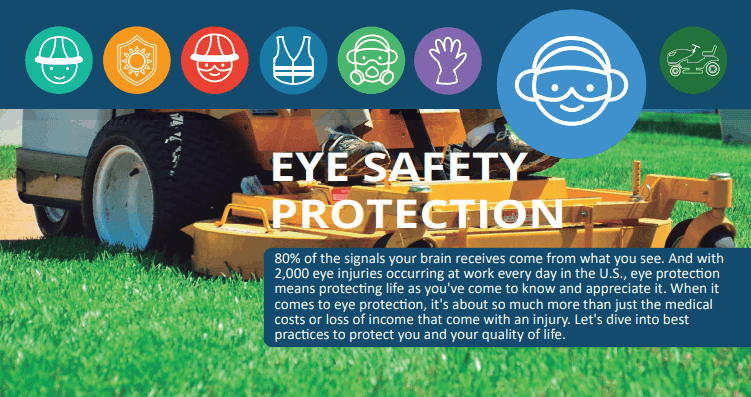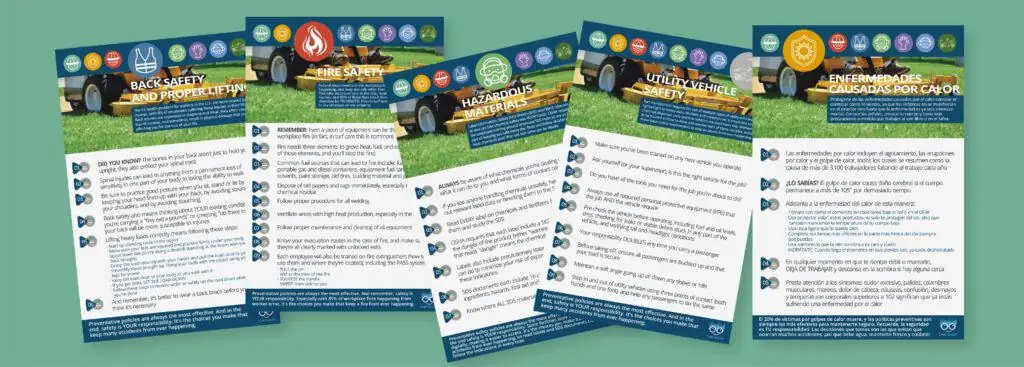
Your eyes are precious.
Did you know that 80% of the signals the human brain receives come from the eyes?
Workers in turf management need to take strides to protect their eyes from dangerous chemicals and potential injuries. The list of possible accidents is long.
Taking care of a golf course, for example, exposes workers to chemicals and foreign objects, sparks in the shop, flying grass and dirt, and an enormous amount of sun exposure. Each of these will cause eye damage if preventative measures aren’t taken.
By following a few simple—but crucial—safety practices, you could save your or a coworker’s or member’s eyes. Here are our top seven tips for practicing eye safety in turf management.
1. Know the hazards of the job
Be aware of tasks in turf care jobs that bring specific hazards to eyes, like:
While getting some grass in your eye might not seem dangerous, grass flying into your eye from a weed-whacker can cause serious damage to your retina.
Also be aware of anyone around you when you’re doing these jobs. If they aren’t wearing proper protection, you may need to ask them to leave or instruct them to put on safety glasses. (Or, in the case of golf courses and members moving into the area you’re working, you might have to wait until they clear out.)
Understanding the seriousness of the job you’re doing is half the battle to being cautious and practicing the best eye safety.
2. Understand the dangers of specific work areas
Be aware of areas of the turf or facility with specific eye hazards, such as the mechanic’s shop. Whether you’re the one working or you’re just passing through, accidents happen.
Knowing that particular areas are prone to flying debris and taking action to avoid injury is your best bet for safety. Even if there’s not a sign instructing workers to wear protective eyewear, you can take the initiative to assess your surroundings and determine if you should be wearing eye or protection in specific work areas. Understand the dangers of your work area and proceed with caution.
3. Protective eyewear should have an ANSI Z-987 rating or higher
Wear protective eyewear with an ANSI Z-87 rating or greater for weed-whacking, backpack blowing, reel grinding, chemical work, and whenever instructed to do so—even if you’re not the person doing the work.
Respect the minimum required safety rating for eyeglasses. Whether it’s against turf, metals, or chemicals, you want to make sure you have the best protection for the job.
Also, wear protective eyewear in high danger areas even when you aren’t doing any work. Debris from other projects can just as easily cause your eyes harm. Wear proper protective eyewear whenever it’s called for.
4. Machine guards are there for a reason
Use machine guards to prevent the escape of particles while you work on the turf.
While it might seem like an unnecessary extra step to use the guard on tools, machine guards are there for a reason. By using them, you can prevent particles from getting into your or your coworkers’ eyes.
5. Welding curtains are important, too
Use welding curtains for arc flash protection in the shop. While this should be obvious, welding is an extremely dangerous task. You’ll want to take the utmost care when welding and respect the dangerousness of the job.
Use preventative measures like proper eyewear and leather sleeves to protect yourself during any welding-related task. And use welding curtains to protect the people around you, too.
6. Look for warning signs
Always watch for signage indicating “off limits without protective eyewear.” It may seem mundane, but it’s vital to be on the lookout for signs that indicate the need for protective eyewear. You’ll be doing yourself (and your eyes) a favor by heeding the warning signs.
Don’t enter any area with this warning sign without first putting on safety glasses. Even if you’re just stopping in for a moment, you’re better off wearing eye protection than losing an eye.
7. Keep your protective eyewear on until you’re done and gone
Do not remove protective eyewear until you’re done with your task and have left the work area where there are hazards. It might seem like a good idea in the moment to take off your eye protection when you’ve just finished a project, but don’t do it. Wait until you’ve left the area before you remove your safety glasses.
Just because you’re finished working doesn’t mean the people around you are also done. Another worker’s project might disperse debris that can end up injuring your eyes. Keep your eye protection on until you’ve exited the premise where hazardous jobs are going on.
Prevention is the best and most effective policy for avoiding injuries. Wearing protective eyewear during work on the golf course is a defense that you don’t want to go without.
After all, the choices you make before an accident occurs are what will save you or someone else from serious injury when the inevitable happens. Accidents happen, but you have the power to help ensure that permanent injuries don’t. Remember to wear eye protection as needed and always follow eye safety procedures.
